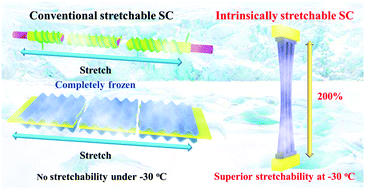Stretchable supercapacitor at −30 °C†
Abstract
At relatively low temperature (e.g., −30 °C), most flexible supercapacitors that work well at room temperature will lose their stretchability due to the poor cold intolerance of conventional electrolytes and the absence of intrinsically stretchable electrodes. Herein, an anti-freezing and highly stretchable supercapacitor (AF-SSC) was fabricated for the first time by one-step in situ growth of polyaniline onto an organohydrogel polyelectrolyte from cross-linked polyacrylamide networks soaked by ethylene glycol/water/H2SO4. As no extra stretchable substrates (e.g. elastic fiber, polydimethylsiloxane, rubber, etc.) or predefining stretchable structures (e.g. helical, spring, wrinkle, honeycombed structures etc.) are needed in such a design, the prepared AF-SSC shows a high mechanical stretchability of 200% at −30 °C and can be repeatedly stretched for 100 cycles without significant capacitance loss. Besides, an impressive capacitance retention of 73.1% at −30 °C is achieved when the current density increases by 20 times, which is much higher than those of stretchable supercapacitors based on pseudocapacitive materials that operate at room temperature. Furthermore, the device shows an ultralong lifespan with 91.7% capacitance retention after 100 000 cycles at −30 °C, outperforming all stretchable supercapacitors reported previously. With other merits of high compressibility, strong adhesion, good processability and excellent anti-drying ability, the current device is an ideal power source to drive multi-functional electronic components in real-life scenarios.

- This article is part of the themed collection: Energy & Environmental Science Recent HOT Articles


 Please wait while we load your content...
Please wait while we load your content...